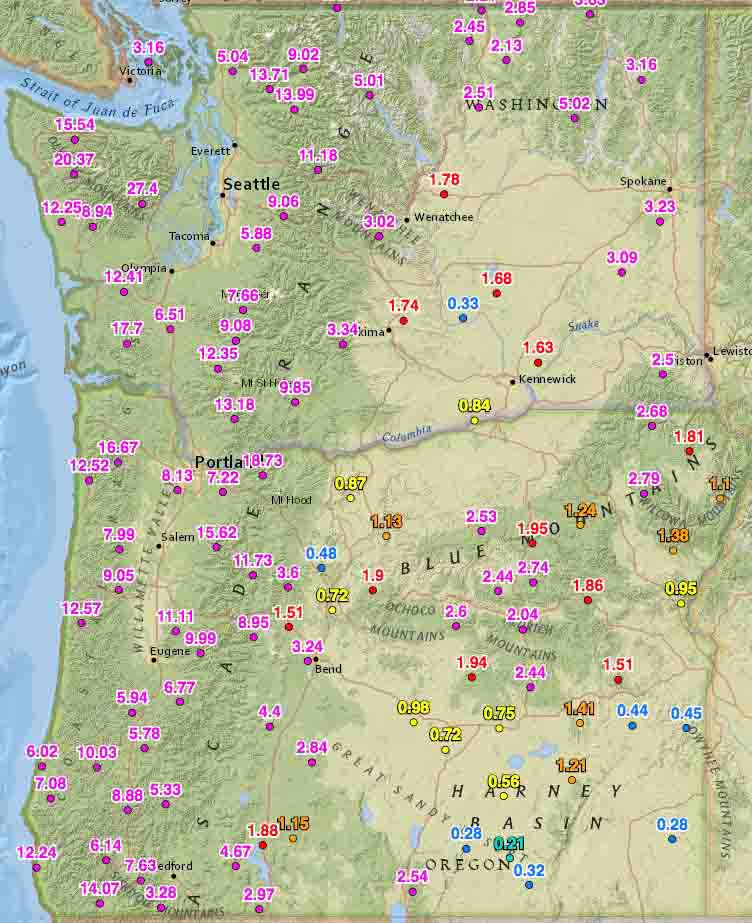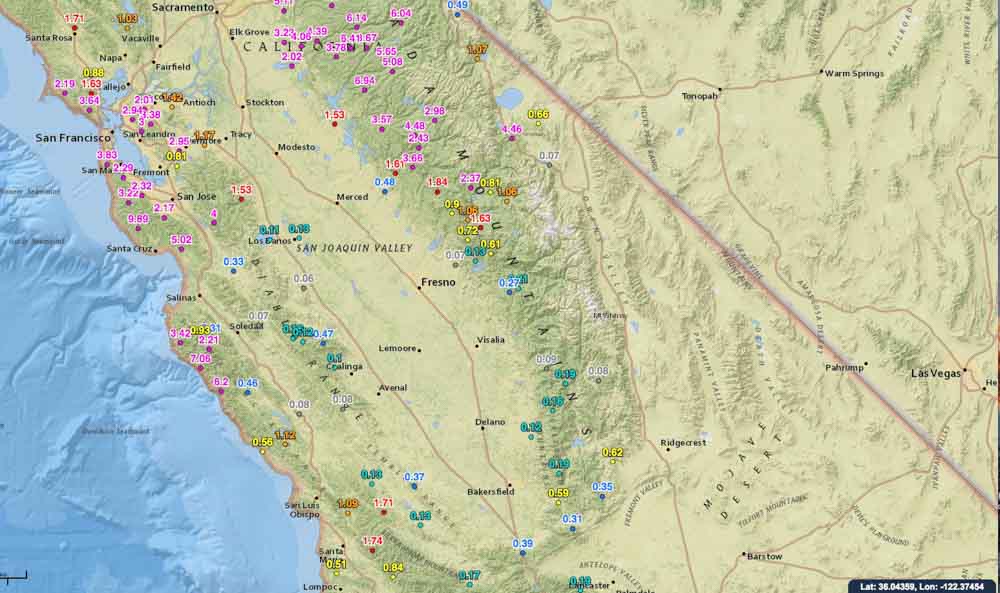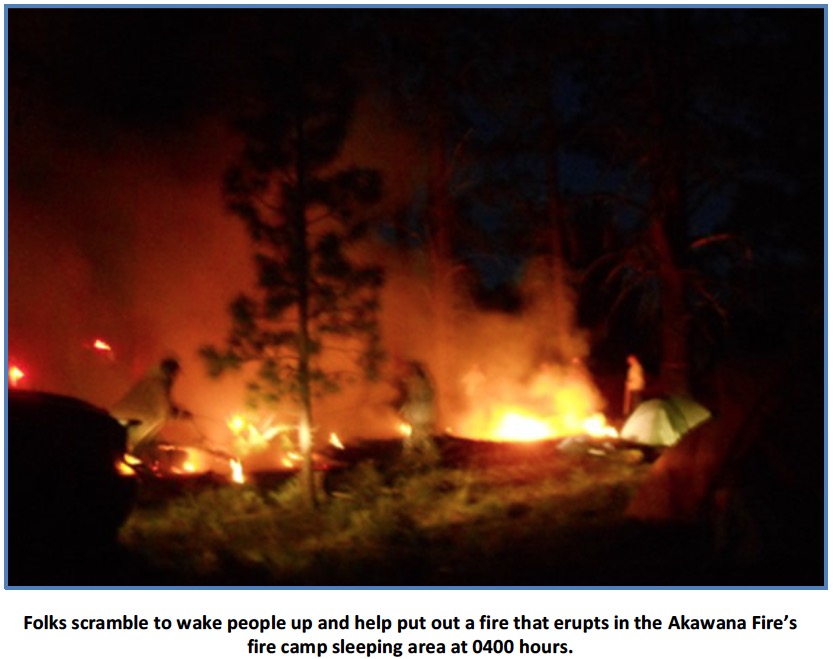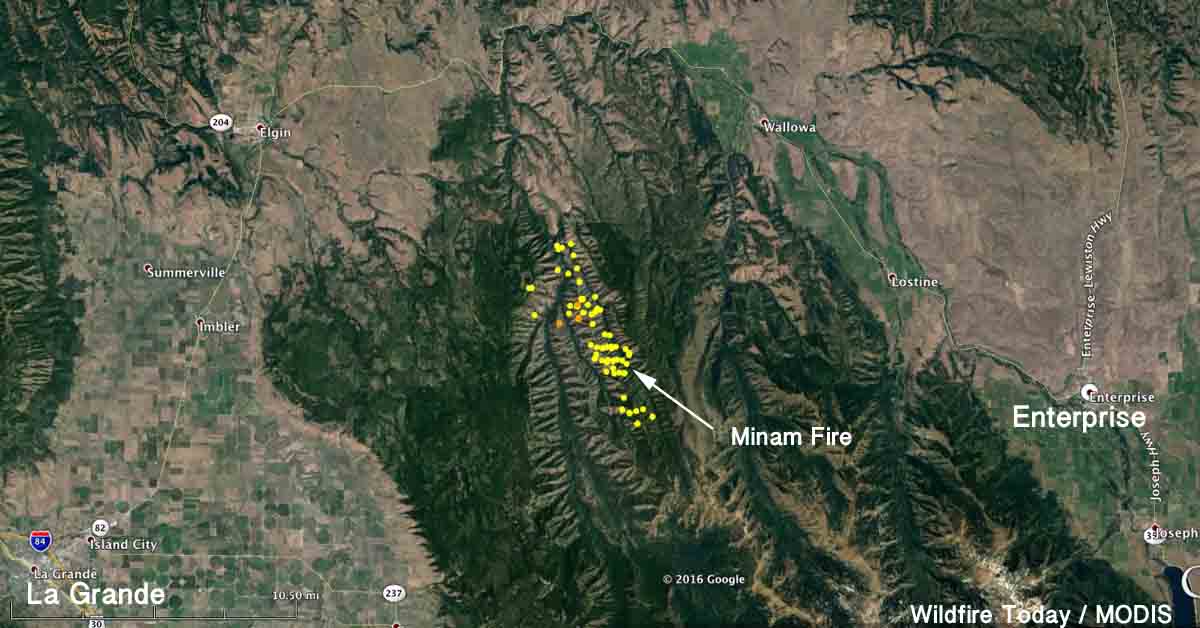I’ve never seen anything quite like this.
BLM firefighters save dozens of endangered pygmy rabbits from #wildfire ????? Story: https://t.co/ndkmblhijg ? @WDFW #wildlife pic.twitter.com/7umEScLsDC
— BLM Oregon (@BLMOregon) July 7, 2017
News and opinion about wildland fire
I’ve never seen anything quite like this.
BLM firefighters save dozens of endangered pygmy rabbits from #wildfire ????? Story: https://t.co/ndkmblhijg ? @WDFW #wildlife pic.twitter.com/7umEScLsDC
— BLM Oregon (@BLMOregon) July 7, 2017

Rainfall over the last two weeks has slowed or in some cases, ended the wildfire season in some areas.
On October 19 we ran the numbers for the accumulated precipitation for the last 14 days in the western states. These maps show amounts that exceeded 0.05 inches at some of the Interagency Remote Automatic Weather Stations (RAWS).
Washington, Oregon, and northern California have received a good soaking and I would imagine that local fire officials may be declaring an end to the fire season. Of course this is not unusual for these areas this time of the year, and some locations had already seen their season end. But what IS unusual, is the high amount of moisture that occurred in just two weeks.
You can click on the images to see larger versions.


Continue to see maps for the other western states.
Continue reading “Rainfall in western states slows wildfire season in many areas”
 This summer a fire of unknown cause erupted in the sleeping area at the fire camp for the Akawana Fire near Sisters, Oregon. It occurred at 4 a.m. in a night shift sleeping area when apparently all of the affected tents were empty.
This summer a fire of unknown cause erupted in the sleeping area at the fire camp for the Akawana Fire near Sisters, Oregon. It occurred at 4 a.m. in a night shift sleeping area when apparently all of the affected tents were empty.
Here is an excerpt from the report released by the Wildland Fire Lessons Learned Center:
…On Saturday June 11, at approximately 0400, a food unit worker and camp night watchman simultaneously investigated smoke coming from the fire camp’s west side in the night shift sleeping area. They discovered a fire burning in pine litter under the ponderosa pine trees with two-foot flame lengths—being wind-driven to the east.
The night watchman went to the camp’s Communications Unit to have them call 911 while the food unit worker started waking up the people inside the tents located in the fire’s path.
One person who was awakened went to the parking area to get his wildland fire engine to respond to the fire. Other personnel grabbed hand tools and pulled partially burning tents out of the fire’s path. Through the 911 emergency system, the local Camp Sherman/Sisters Rural Fire Department was dispatched and two engines responded to assist in extinguishing the fire.
The fire was contained to an approximate 50 by 75 feet area with three tents totally destroyed and two tents pulled out of the fire that were damaged beyond use.
Tent Pulled from Flames has Two Propane Tanks
Much to the responders’ surprise, one of the tents pulled out of the flames contained two small backpack-sized propane tanks for either a small stove or heater. While neither of the tanks were hooked to a device or suspected of contributing to the fire’s origin, if this tent had not been pulled from the flames, it could have provided a serious safety hazard to first responders.
After the fire was extinguished, both a wildland and structural fire investigator arrived on scene to take over the fire investigation. The tent determined to be the fire’s origin was identified to a specific 20-person contract crew on nightshift. As the night shift crews returned to camp and reported to Ground Support, the fire investigators spoke with this crew first.
The tent of the fire’s origin belonged to the Crew Boss of this 20-person crew. There was evidence of cigarette cartons inside the tent and fresh cigarette butts outside the tent. This was a non-smoking area. There was a designated smoking area on an asphalt cul-de-sac with metal cans for cigarette butts approximately 200 feet from the fire.
However, due to high relative humidity during the night shift and very cool temperatures in the early morning— approximately 10 hours earlier when the night shift crews would have been leaving camp—the discarded cigarette butts discovered near the origin were determined unlikely to have started the fire…
I assume that the synthetic materials used to manufacture one-person tents are extremely flammable, and while burning they melt and drip the flaming liquified fuel. If someone is inside a tent that catches fire from the outside they might be subject to serious burn injuries — or worse.
You can read the entire report, including the lessons learned, HERE.
Above: Minam Fire, Friday September 30, 2016. USFS photo.
A prescribed fire on the Wallowa-Whitman National Forest escaped the day after it was conducted in northeast Oregon. The 2,000-acre project was ignited with a helicopter on Thursday, September 29 as a continuation of previous prescribed burning activities in the Minam drainage within the Eagle Cap Wilderness Area about 21 miles northeast of La Grande, Oregon.
Late in the afternoon of the next day, Friday, during a helicopter flight to check the status of the project, fire managers found a spot fire east of the burn area across Trout Creek. Due to the time of day, it was determined that firefighters could not safely access the spot fire until the following day.

Early Saturday, October 1, a powerful thunderstorm moved through the area bringing stronger than expected winds and very little moisture. As planned, firefighters hiked into the spot fire on Saturday and found that the winds had spread the spot fire to the east, upslope onto Cougar Ridge, and ultimately outside the planned prescribed fire area.
The Minam Fire was declared an escape Saturday afternoon, October 1st, when fire managers determined that they would not be able to contain the portion of the fire that had spread outside of the planned perimeter within the next 24 hours, which is a criteria for declaring an escaped prescribed fire.
Cooler weather kept the spread of the fire minimal into Sunday as additional crews and aircraft arrived on scene to support the suppression efforts.
As of Sunday, October 2, the escaped fire had burned 750 acres.
Highlights of recent news about wildland fire.
California has fewer inmates available for fighting wildfires
With fewer inmates available for fighting fires, the state of California is turning to civilian crews within their Conservation Corps.
From KCRA:
…But the number of available inmates is declining because counties now oversee most lower-level felons under a law aimed at easing prison overcrowding. In addition, there are fewer incentives for inmates to risk their lives since a federal court broadened an early release program for firefighters to include other inmates.
The state is about 600 inmates short of the 4,300 prisoners who could be available for fire lines. So this year, the California Conservation Corps reopened a camp to train three crews of young civilians to do the same backbreaking work as the inmates. Corps Director Bruce Saito expects to create at least four more fire crews with roughly 15 members each by next summer and a half-dozen new crews during each of the next two years.
The corps has more than 1,400 members, but fewer than 200 currently work alongside local, state and federal firefighters battling blazes in rural areas.
The members include both men and women and range in age from 18 to 25. They enlist for one year and earn the state’s minimum wage of $10 an hour. Military veterans can enroll until they turn 30…
Oregon sues 3 people responsible for starting the Ferguson Fire
Oregon hopes to recover $892,082 from three individuals who they say are responsible for starting the Ferguson Fire that burned 200 acres and destroyed two structures in Klamath County in July 2014.
The suit alleges that Joe Askins started a campfire, then took a nap. When he awoke, the campfire had escaped. Askins also said “I’ll take all the blame for the fire,” according to the lawsuit.
More evidence that beetle-killed forests do not increase the risk of catastrophic wildfires.
An article at News Deeply summarizes several research studies which mostly concluded that beetle-killed forests do not burn more severely than forests that have not been attacked by the insects. This is in spite of statements to the contrary by the Secretary of Agriculture, a spokesperson for CAL FIRE, and media stories about trees that are now part of a “tinder box”.
Air tanker 132 starts contract in Australia

Fire Aviation reports that Coulson’s Air Tanker 132 started its contract with New South Wales on September 6, helping to provide air support for wildland firefighters in Australia. This is the second year in a row that the L-382G, a variant of the C-130 platform, has worked down under during their summer bushfire season.
Cheyenne is concerned about the effects of the Snake Fire on their water system
“The location of the fire is close proximity to our major watershed collection area for the Hog Park Reservoir” said Dena Egenhoff, the Board of Public Utilities’ (BOPU) Water Conservation Manager. “We are unable to know the impact of the Snake Fire at this time, but the location suggests there may be some adverse impacts to the City of Cheyenne’s water collection system.” As of September 11, 2016, the Hog Park Reservoir is 91.8% full
For Cheyenne, BOPU collects water in the Little Snake River drainage from snow melt and streams and transports it under a mountain by a tunnel to the eastside of the Continental Divide. That water is then stored in Hog Park Reservoir. From there, the collected water from Hog Park Reservoir is traded for water in Rob Roy Reservoir which can more easily be transported without pumping to Cheyenne. “In this way, the amount of water can be exchanged between the two different Mountain Ranges with all water rights being satisfied,” said Dena Egenhoff.
The Snake fire is in south-central Wyoming just north of the Colorado border. It is 115 air miles miles west of Cheyenne, and 20 miles west of the 38,000-acre Beaver Creek Fire that has been burning in Colorado and Wyoming since July 19, 2016.
That’s the title of a video, all in slow motion, showing firefighters working on the Bybee Creek Fire in Crater Lake National Park.
Squad 21 out of the Fremont-Winema National Forest working on the Bybee Creek Fire in Crater Lake National Park. Video shot and edited by David Corr.